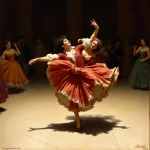Ballet: La Bayadère (Ludwig Minkus, 1877)

Introduction
La Bayadère is a classic ballet that has captivated audiences since its premiere in 1877. Choreographed by Marius Petipa and set to the music of Ludwig Minkus, this ballet is a tale of love, betrayal, and redemption set against the exotic backdrop of ancient India. The ballet premiered at the Imperial Bolshoi Kamenny Theatre in St. Petersburg, Russia, and has since become a staple in the repertoire of major ballet companies worldwide.
The story revolves around the tragic love affair between Nikiya, a temple dancer (bayadère), and Solor, a noble warrior. Their love is thwarted by jealousy, deceit, and the rigid social structures of their time, leading to a dramatic and poignant conclusion.
Historical Background
Creation and Development
La Bayadère was created during a period of significant cultural and artistic development in Russia. The late 19th century was a time when Russian ballet was flourishing, heavily influenced by French and Italian traditions. Marius Petipa, a French ballet master, was a dominant figure in the Russian ballet scene, known for his grandiose and technically demanding choreographies.
The inspiration for La Bayadère came from various sources, including Indian literature and folklore, as well as the romanticized Western perceptions of the East. The ballet’s exotic setting and themes of forbidden love and spiritual transcendence were reflective of the era’s fascination with Orientalism.
The collaboration between Petipa and Minkus was crucial to the ballet’s success. Minkus, an Austrian composer, was well-regarded for his ability to create music that complemented Petipa’s intricate choreography. Together, they crafted a ballet that was both visually and musically stunning.
Premiere and Reception
La Bayadère premiered on February 4, 1877, at the Imperial Bolshoi Kamenny Theatre in St. Petersburg. The initial reception was mixed; while some critics praised the ballet’s lavish production and Minkus’s evocative score, others were less impressed by the storyline and its execution. However, the ballet quickly gained popularity, thanks in part to the performances of the original cast, which included Ekaterina Vazem as Nikiya and Lev Ivanov as Solor.
Over the years, La Bayadère has seen numerous revivals and reinterpretations, solidifying its place as a beloved classic in the ballet canon.
Synopsis of the Ballet
Act I Summary
The ballet opens in a sacred temple in ancient India, where Nikiya, a beautiful temple dancer, is introduced. She is in love with Solor, a noble warrior, and they secretly pledge their love to each other. However, their love is forbidden, as Nikiya is dedicated to serving the gods. The High Brahmin, who is also in love with Nikiya, discovers their secret and vows to destroy Solor.
Meanwhile, the Rajah Dugmanta of Golconda has chosen Solor to marry his daughter, Gamzatti. Unaware of Solor’s love for Nikiya, Gamzatti eagerly anticipates the union. When the High Brahmin informs the Rajah of Solor and Nikiya’s love, the Rajah decides to eliminate Nikiya to ensure the marriage goes ahead.
Act II Summary
The second act takes place in the Rajah’s palace, where preparations for Solor and Gamzatti’s wedding are underway. Nikiya is summoned to dance at the celebration, unaware of the plot against her. During her performance, she is given a basket of flowers, which she believes is a gift from Solor. However, the basket contains a deadly snake, planted by Gamzatti. Nikiya is bitten and, despite being offered an antidote by the High Brahmin, she chooses to die rather than live without Solor.
Act III Summary
The final act, often referred to as “The Kingdom of the Shades,” is one of the most famous scenes in classical ballet. It depicts Solor’s opium-induced vision of the afterlife, where he is reunited with Nikiya. The scene is renowned for its ethereal beauty and the precision of the corps de ballet, who represent the shades (spirits) of deceased temple dancers. The ballet concludes with Solor and Nikiya’s spirits ascending to the heavens, symbolizing their eternal love and redemption.
Finale
The conclusion of La Bayadère is both tragic and uplifting. While the earthly lives of Nikiya and Solor end in sorrow, their spirits find peace and unity in the afterlife. This resolution underscores the ballet’s themes of love, sacrifice, and spiritual transcendence.
Musical Composition
Composer’s Role
Ludwig Minkus, the composer of La Bayadère, played a pivotal role in shaping the ballet’s musical landscape. Minkus was known for his ability to create melodies that were both memorable and perfectly suited to the demands of ballet choreography. His score for La Bayadère is characterized by its lush orchestration and evocative themes, which enhance the emotional depth of the story.
Musical Themes and Motifs
The music of La Bayadère features several recurring themes and motifs that help to underscore the narrative. For example, Nikiya’s leitmotif is a delicate, lyrical melody that reflects her purity and devotion. In contrast, the music associated with the Rajah and Gamzatti is more grandiose and imposing, highlighting their authority and ambition. The “Kingdom of the Shades” scene is particularly notable for its hauntingly beautiful music, which creates an otherworldly atmosphere.
Famous Recordings and Performances
There have been numerous recordings and performances of Minkus’s score for La Bayadère. Some of the most iconic include recordings by the Bolshoi Theatre Orchestra and the Kirov Orchestra, both of which capture the richness and complexity of Minkus’s music. These recordings are often used as reference points for contemporary productions of the ballet.
Choreography and Dance
Choreographer’s Vision
Marius Petipa’s vision for La Bayadère was one of grandeur and technical brilliance. Petipa was known for his meticulous attention to detail and his ability to create intricate, expressive choreography. In La Bayadère, he combined elements of classical ballet with exotic, Eastern-inspired movements to create a unique and captivating dance language.
Signature Dance Numbers
One of the most famous dance numbers in La Bayadère is the “Kingdom of the Shades” scene. This section features a series of arabesques performed by the corps de ballet, creating a mesmerizing, wave-like effect. Another highlight is the Pas de Deux between Nikiya and Solor, which showcases the dancers’ technical prowess and emotional connection.
Notable Interpretations
Over the years, different productions of La Bayadère have offered various interpretations of Petipa’s original choreography. Some have emphasized the ballet’s exotic elements, while others have focused on its classical purity. Notable interpretations include those by Rudolf Nureyev for the Paris Opera Ballet and Natalia Makarova for the American Ballet Theatre, both of which have been praised for their innovative approaches.
Characters and Roles
Main Characters
- Nikiya: A temple dancer (bayadère) who is deeply in love with Solor. She is characterized by her grace, purity, and tragic fate.
- Solor: A noble warrior who loves Nikiya but is betrothed to Gamzatti. He is torn between duty and love.
- Gamzatti: The Rajah’s daughter, who is determined to marry Solor and will stop at nothing to eliminate her rival, Nikiya.
- The High Brahmin: A priest who is in love with Nikiya and seeks to destroy Solor out of jealousy.
Supporting Characters
- Rajah Dugmanta: The ruler who arranges the marriage between Solor and Gamzatti.
- Magdaveya: Solor’s servant, who provides comic relief in the otherwise dramatic narrative.
Famous Dancers
Many renowned dancers have portrayed the roles in La Bayadère. Some of the most notable include:
- Ekaterina Vazem: The original Nikiya, known for her expressive dancing and emotional depth.
- Rudolf Nureyev: A legendary Solor, celebrated for his technical brilliance and dramatic presence.
- Natalia Makarova: A celebrated interpreter of Nikiya, known for her lyrical grace and powerful stage presence.
Cultural and Artistic Impact
Influence on Ballet and Dance
La Bayadère has had a profound influence on the world of ballet. Its innovative choreography and dramatic storytelling have inspired countless choreographers and dancers. The “Kingdom of the Shades” scene, in particular, is considered a masterpiece of classical ballet and has been referenced and reinterpreted in numerous other works.
Cultural Significance
The ballet’s themes of love, betrayal, and spiritual transcendence have resonated with audiences for over a century. La Bayadère has also made its mark in popular culture, with references in literature, film, and other media. Its exotic setting and dramatic narrative continue to captivate and inspire new generations of artists and audiences.
Legacy and Revivals
La Bayadère has seen numerous revivals and reinterpretations over the years. Major ballet companies around the world continue to perform the ballet, often bringing their unique perspectives to the production. Notable revivals include those by the Bolshoi Ballet, the Mariinsky Ballet, and the American Ballet Theatre, each of which has contributed to the ballet’s enduring legacy.
Iconic Productions
Historic Productions
Some of the most famous historical productions of La Bayadère include the original 1877 premiere at the Imperial Bolshoi Kamenny Theatre and the 1900 revival by Petipa himself. These productions set the standard for future interpretations and featured some of the most celebrated dancers of their time.
Contemporary Productions
Recent productions of La Bayadère have brought fresh perspectives to the ballet while honoring its classical roots. For example, the Paris Opera Ballet’s production, staged by Rudolf Nureyev, is known for its dramatic intensity and technical precision. The American Ballet Theatre’s production, staged by Natalia Makarova, is celebrated for its lyrical beauty and emotional depth.
Production Design
The set, costume, and lighting design in various productions of La Bayadère have played a crucial role in bringing the ballet’s exotic world to life. Lavish sets depicting temples, palaces, and mystical landscapes, along with opulent costumes inspired by Indian culture, create a visually stunning experience. Lighting design enhances the mood and atmosphere, particularly in the ethereal “Kingdom of the Shades” scene.
Critical Reception and Reviews
Initial Critical Response
At the time of its premiere, La Bayadère received mixed reviews from critics. While some praised the ballet’s lavish production and Minkus’s evocative score, others were less impressed by the storyline and its execution. However, the ballet quickly gained popularity among audiences, thanks in part to the performances of the original cast.
Modern Reviews
Contemporary critics and audiences continue to hold La Bayadère in high regard. The ballet is praised for its technical brilliance, emotional depth, and timeless themes. Modern productions are often lauded for their innovative interpretations and high production values, ensuring that La Bayadère remains a beloved classic in the world of ballet.
Fun Facts and Trivia
Behind-the-Scenes Stories
One interesting anecdote from the original production of La Bayadère involves Ekaterina Vazem, the first Nikiya. During rehearsals, she reportedly had a heated argument with Petipa over a particular step, which she found too difficult. Petipa eventually relented and modified the choreography to suit her abilities.
Notable Performers
Over the years, many famous dancers have left their mark on La Bayadère. Rudolf Nureyev’s portrayal of Solor is legendary, as is Natalia Makarova’s interpretation of Nikiya. These dancers brought their unique artistry and technical prowess to the roles, elevating the ballet to new heights.
Trivia
- Exotic Inspiration: The ballet’s setting and themes were inspired by Western fascination with the exotic East during the 19th century.
- Opium Dream: The “Kingdom of the Shades” scene is often interpreted as Solor’s opium-induced vision, adding a layer of surrealism to the ballet.
- Iconic Scene: The “Kingdom of the Shades” is one of the most famous scenes in classical ballet, known for its precision and ethereal beauty.
Conclusion
Summary of the Ballet’s Importance
La Bayadère is a significant work in the world of ballet, known for its technical brilliance, emotional depth, and timeless themes. The collaboration between Marius Petipa and Ludwig Minkus resulted in a ballet that continues to captivate audiences with its exotic setting, dramatic narrative, and stunning choreography.
Final Thoughts
La Bayadère remains a beloved classic in the ballet repertoire, celebrated for its beauty, complexity, and emotional resonance. Whether you are a seasoned ballet enthusiast or a newcomer to the art form, experiencing a performance of La Bayadère is a journey into a world of love, betrayal, and spiritual transcendence. We encourage you to watch a performance or listen to the score to fully appreciate the enduring magic of this timeless ballet.
FAQ
What is the central theme of this ballet?
The central theme of La Bayadère is the tragic love affair between Nikiya, a temple dancer, and Solor, a noble warrior, set against the backdrop of ancient India. The ballet explores themes of love, betrayal, and spiritual transcendence.
Who are the main characters in this ballet?
The main characters in La Bayadère are Nikiya, a temple dancer; Solor, a noble warrior; Gamzatti, the Rajah’s daughter; and the High Brahmin, a priest who is in love with Nikiya.
What is the most famous dance number in this ballet?
The most famous dance number in La Bayadère is the “Kingdom of the Shades” scene, known for its ethereal beauty and the precision of the corps de ballet.
How long does a typical performance of this ballet last?
A typical performance of La Bayadère lasts approximately two to three hours, including intermissions.
Are there any modern adaptations of this ballet?
Yes, there have been numerous modern adaptations and reinterpretations of La Bayadère, including productions by the Paris Opera Ballet and the American Ballet Theatre, which bring fresh perspectives to the classic ballet.
Why is this ballet considered important in the history of dance?
La Bayadère is considered important in the history of dance due to its innovative choreography, emotional depth, and timeless themes. It has influenced countless choreographers and dancers and remains a beloved classic in the ballet repertoire.





